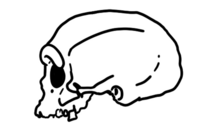
Back بشراني لونغي Arabic Homo longi Azerbaijani Homo longi German Homo longi Spanish Dragoi gizakia Basque مرد اژدهایی Persian Homo longi Finnish Homme de Harbin French הומו לונגי HE Homo longi Italian
| Homo longi Temporal range: Middle Pleistocene
| |
|---|---|

| |

| |
| HBSM2018-000018(A) cranium | |
| Scientific classification | |
| Domain: | Eukaryota |
| Kingdom: | Animalia |
| Phylum: | Chordata |
| Class: | Mammalia |
| Order: | Primates |
| Suborder: | Haplorhini |
| Infraorder: | Simiiformes |
| Family: | Hominidae |
| Subfamily: | Homininae |
| Tribe: | Hominini |
| Genus: | Homo |
| Species: | †H. longi
|
| Binomial name | |
| †Homo longi Ji et al., 2021
| |
Homo longi is an extinct species of archaic human identified from a nearly complete skull, nicknamed 'Dragon Man', from Harbin on the Northeast China Plain, dating to at minimum 146,000 years ago during the Middle Pleistocene. The skull was discovered in 1933 along the Songhua River while the Dongjiang Bridge was under construction for the Manchukuo National Railway. Due to a tumultuous wartime atmosphere, it was hidden and only brought to paleoanthropologists in 2018. H. longi has been hypothesized to be the same species as the Denisovans, but this cannot be confirmed without genetic testing.
H. longi is broadly anatomically similar to other Middle Pleistocene Chinese specimens. Like other archaic humans, the skull is low and long, with massively developed brow ridges, wide eye sockets, and a large mouth. The skull is the longest ever found from any human species. Like modern humans, the face is rather flat, but with a larger nose. The brain volume was 1,420 cc, within the range of modern humans and Neanderthals.